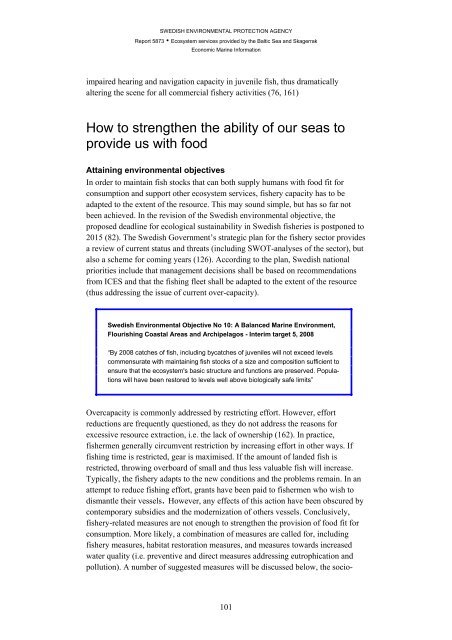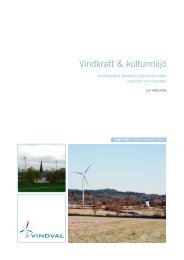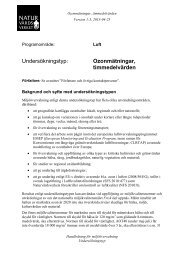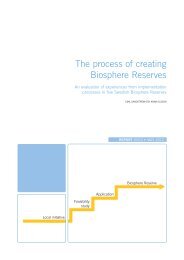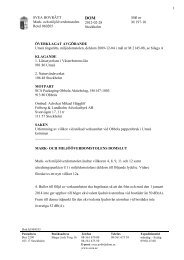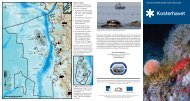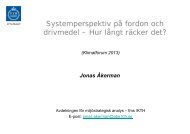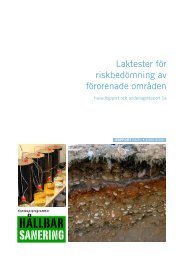Ecosystem services provided by the Baltic Sea ... - Naturvårdsverket
Ecosystem services provided by the Baltic Sea ... - Naturvårdsverket
Ecosystem services provided by the Baltic Sea ... - Naturvårdsverket
Create successful ePaper yourself
Turn your PDF publications into a flip-book with our unique Google optimized e-Paper software.
SWEDISH ENVIRONMENTAL PROTECTION AGENCY<br />
Report 5873 • <strong>Ecosystem</strong> <strong>services</strong> <strong>provided</strong> <strong>by</strong> <strong>the</strong> <strong>Baltic</strong> <strong>Sea</strong> and Skagerrak<br />
Economic Marine Information<br />
impaired hearing and navigation capacity in juvenile fish, thus dramatically<br />
altering <strong>the</strong> scene for all commercial fishery activities (76, 161)<br />
How to streng<strong>the</strong>n <strong>the</strong> ability of our seas to<br />
provide us with food<br />
Attaining environmental objectives<br />
In order to maintain fish stocks that can both supply humans with food fit for<br />
consumption and support o<strong>the</strong>r ecosystem <strong>services</strong>, fishery capacity has to be<br />
adapted to <strong>the</strong> extent of <strong>the</strong> resource. This may sound simple, but has so far not<br />
been achieved. In <strong>the</strong> revision of <strong>the</strong> Swedish environmental objective, <strong>the</strong><br />
proposed deadline for ecological sustainability in Swedish fisheries is postponed to<br />
2015 (82). The Swedish Government’s strategic plan for <strong>the</strong> fishery sector provides<br />
a review of current status and threats (including SWOT-analyses of <strong>the</strong> sector), but<br />
also a scheme for coming years (126). According to <strong>the</strong> plan, Swedish national<br />
priorities include that management decisions shall be based on recommendations<br />
from ICES and that <strong>the</strong> fishing fleet shall be adapted to <strong>the</strong> extent of <strong>the</strong> resource<br />
(thus addressing <strong>the</strong> issue of current over-capacity).<br />
Swedish Environmental Objective No 10: A Balanced Marine Environment,<br />
Flourishing Coastal Areas and Archipelagos - Interim target 5, 2008<br />
“By 2008 catches of fish, including <strong>by</strong>catches of juveniles will not exceed levels<br />
commensurate with maintaining fish stocks of a size and composition sufficient to<br />
ensure that <strong>the</strong> ecosystem's basic structure and functions are preserved. Populations<br />
will have been restored to levels well above biologically safe limits”<br />
Overcapacity is commonly addressed <strong>by</strong> restricting effort. However, effort<br />
reductions are frequently questioned, as <strong>the</strong>y do not address <strong>the</strong> reasons for<br />
excessive resource extraction, i.e. <strong>the</strong> lack of ownership (162). In practice,<br />
fishermen generally circumvent restriction <strong>by</strong> increasing effort in o<strong>the</strong>r ways. If<br />
fishing time is restricted, gear is maximised. If <strong>the</strong> amount of landed fish is<br />
restricted, throwing overboard of small and thus less valuable fish will increase.<br />
Typically, <strong>the</strong> fishery adapts to <strong>the</strong> new conditions and <strong>the</strong> problems remain. In an<br />
attempt to reduce fishing effort, grants have been paid to fishermen who wish to<br />
dismantle <strong>the</strong>ir vessels. However, any effects of this action have been obscured <strong>by</strong><br />
contemporary subsidies and <strong>the</strong> modernization of o<strong>the</strong>rs vessels. Conclusively,<br />
fishery-related measures are not enough to streng<strong>the</strong>n <strong>the</strong> provision of food fit for<br />
consumption. More likely, a combination of measures are called for, including<br />
fishery measures, habitat restoration measures, and measures towards increased<br />
water quality (i.e. preventive and direct measures addressing eutrophication and<br />
pollution). A number of suggested measures will be discussed below, <strong>the</strong> socio-<br />
101


